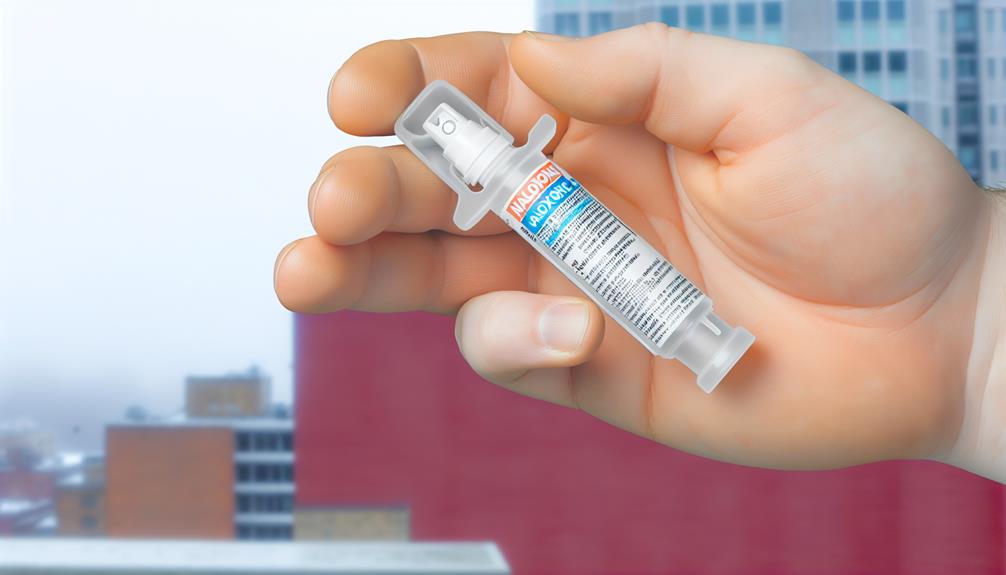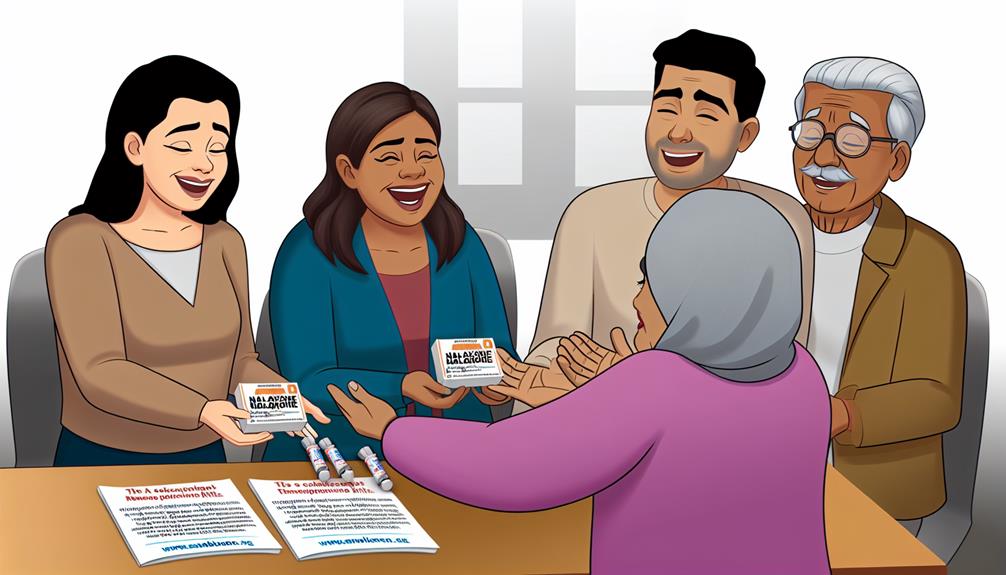In a world where the shadow of addiction looms large, hope emerges like a beacon of light. Naloxone, a medication designed to reverse opioid overdoses, has become increasingly accessible in recent years.
But why is this life-saving antidote readily available? The answer lies not only in the devastating impact of the opioid epidemic but also in the recognition of the urgent need to confront it head-on.
As you delve into the discussion ahead, you will discover the crucial reasons behind the widespread availability of naloxone and the policies and initiatives that support its accessibility. Brace yourself for a journey that unveils the significance of quick access to this vital medication.
The Opioid Epidemic

The opioid epidemic is a widespread crisis affecting communities across the nation, with devastating consequences for individuals and society as a whole. The opioid crisis has led to a significant increase in opioid addiction and overdose deaths. According to the National Institute on Drug Abuse (NIDA), more than 130 people die every day in the United States from opioid-related drug overdoses. This crisis has created an urgent need for effective addiction treatment options.
Addiction treatment plays a crucial role in addressing the opioid crisis. It aims to help individuals overcome their addiction and regain control over their lives. Various evidence-based treatments are available, including medication-assisted treatment (MAT) and behavioral therapies. MAT combines medications, such as methadone, buprenorphine, or naltrexone, with counseling and behavioral therapies to provide a comprehensive approach to treatment. These medications help manage withdrawal symptoms and cravings, enabling individuals to focus on their recovery.
Furthermore, behavioral therapies, such as cognitive-behavioral therapy (CBT) and contingency management, have also proven effective in treating opioid addiction. CBT helps individuals identify and change negative thought patterns and behaviors associated with drug use, while contingency management provides incentives for positive behaviors, such as maintaining abstinence. These evidence-based treatments have shown promising results in reducing opioid use, improving treatment retention, and decreasing overdose deaths.
To address the opioid crisis effectively, it's crucial to expand access to addiction treatment services. Increasing the availability of evidence-based treatments, ensuring insurance coverage for these services, and reducing treatment barriers can help individuals struggling with opioid addiction receive the necessary care. Additionally, integrating addiction treatment into primary care settings can help identify and provide early interventions for individuals at risk of developing opioid use disorder. By implementing these strategies, we can make significant progress in combating the opioid epidemic and improving the lives of those affected.
Understanding Prescription Drug Abuse
Prescription drug abuse is a significant problem that affects individuals across various demographics and can have severe consequences for both physical and mental health. It's crucial to understand the nature of this issue in order to effectively address it. Here are three key points to consider:
- Opioid addiction: Prescription opioids, such as oxycodone and hydrocodone, are highly addictive substances. When used improperly or without medical supervision, they can lead to dependence and addiction. This can have devastating effects on individuals and their loved ones, causing financial strain, relationship problems, and even overdose.
- Prevention measures: To combat prescription drug abuse, prevention is key. Healthcare providers play a crucial role in prescribing opioids responsibly and monitoring patients for signs of misuse. Public awareness campaigns can educate individuals about the risks of prescription drug abuse and the importance of properly disposing of unused medications. Additionally, implementing prescription drug monitoring programs can help identify individuals who may be obtaining multiple prescriptions from different providers, a common practice among those seeking to misuse or sell prescription drugs.
- Treatment and support: For those already struggling with prescription drug addiction, access to effective treatment and support services is essential. Medication-assisted treatment, such as the use of medications like buprenorphine and methadone, can help individuals manage withdrawal symptoms and cravings. Counseling and behavioral therapies can also address the underlying causes of addiction and provide coping strategies for recovery.
Naloxone: An Opioid Overdose Reversal Medication

Naloxone, an essential medication used for reversing opioid overdoses, has been proven to be highly effective in saving lives. Its availability plays a crucial role in opioid crisis management.
Naloxone works by rapidly binding to opioid receptors in the brain, displacing the opioids and reversing the effects of an overdose. It's most commonly administered as a nasal spray or injection.
One of the reasons why naloxone is readily accessible is because it can be safely administered by non-medical professionals, including family members, friends, and bystanders. This accessibility allows for immediate intervention in the event of an overdose, potentially preventing fatal outcomes.
Studies have shown that naloxone distribution programs are associated with a reduction in overdose deaths. For instance, a study conducted in Massachusetts found that communities with increased naloxone availability had a significantly lower overdose death rate compared to those without such programs. This evidence supports the importance of making naloxone readily accessible to combat the opioid crisis.
Furthermore, naloxone availability is facilitated through various channels, including pharmacies, harm reduction organizations, and community-based programs. These initiatives aim to ensure that naloxone is easily accessible to those at risk of opioid overdose.
The Importance of Quick Access to Naloxone
With naloxone readily accessible, the ability to quickly administer this life-saving medication becomes crucial in preventing fatal outcomes of opioid overdoses. Naloxone is an opioid antagonist that rapidly reverses the effects of opioids, such as respiratory depression, and restores breathing. Its availability is essential for several reasons:
- Public education: Ensuring quick access to naloxone can help raise awareness about opioid overdoses and empower individuals to take action. By educating the public about naloxone and its proper use, more people can become equipped to save lives in emergency situations.
- Harm reduction: Quick access to naloxone aligns with harm reduction strategies, which aim to minimize the negative consequences associated with drug use. By providing naloxone to individuals at risk of opioid overdose, we can mitigate harm and potentially prevent fatal outcomes.
- Timely intervention: Opioid overdoses can quickly escalate, leading to respiratory failure and death. Having naloxone readily accessible allows for immediate intervention, increasing the chances of survival and reducing the long-term consequences of an overdose.
Policies and Initiatives Supporting Naloxone Accessibility

To ensure widespread access to naloxone, various policies and initiatives have been implemented to promote its availability and distribution. These efforts primarily focus on community outreach and harm reduction strategies.
One key policy that supports naloxone accessibility is the implementation of standing orders. Standing orders allow healthcare providers to prescribe naloxone to individuals who are at risk of opioid overdose, without the need for an individual prescription. This removes barriers to access and allows naloxone to be more readily available to those who need it.
Additionally, many states have passed laws to increase access to naloxone. These laws typically include provisions that allow pharmacists to dispense naloxone without a prescription or provide immunity to individuals who administer naloxone in good faith to someone experiencing an overdose. These policies aim to remove legal obstacles and encourage the distribution and use of naloxone.
Community-based organizations and harm reduction programs also play a crucial role in promoting naloxone accessibility. These initiatives often provide training on naloxone administration, distribute naloxone kits to individuals at risk of overdose or their loved ones, and establish overdose prevention programs. By targeting high-risk populations and empowering community members, these programs help ensure that naloxone is readily available in areas most affected by opioid overdose.







